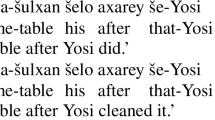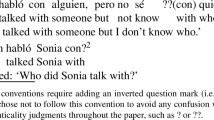Abstract
This paper examines three commentaries on the Śabdapariccheda in Kumārila Bhaṭṭa’s Ślokavārttika, along with the the seventeenth century Bhāṭṭa Mīmāṃsā work, the Mānameyodaya. The focus is the Mīmāṃsā principle that only sentences communicate qualified meanings and Kumārila’s discussion of a potential counter-example to this claim–single words which appear to communicate such content. I argue that there is some conflict among commentators over precisely what Kumārila describes with the phrase sāmarthyād anumeyetvād, although he is most likely describing ellipsis completion through arthāpatti. The paper attempts both a cogent exegesis and philosophical evaluation of the Bhāṭṭa Mīmāṃsā view of ellipsis completion, arguing that there remain internal tensions in the account of ellipsis preferred by the Bhāṭṭa, tensions which are not entirely resolved even by the late date of the Mānameyodaya.
Similar content being viewed by others
Abbreviations
- K:
-
Sucarita Miśra, Kāśikā, in the edition Mīmāṃsāślokavārttika of Kumārilabhaṭṭa with Commentary Kāśikā of Sucaritamiśra, ed. V. A. Ramaswami Sastri, 3 parts, Trivandrum Sanskrit Series Nos. 90, 99, 150, Government Press, Trivandrum 1926, 1929, 1943.
- MM:
-
Nārāyaṇa Bhaṭṭa and Nārāyaṇa Paṇḍita, Mānameyodaya, 3rd edition, eds. C. Kunhan Raja and S. S. Suryanarayana Sastri, The Adyar Library and Research Centre, Adyar 2004.
- MS:
-
Jaimini, Mīmāṃsāsūtra, in the edition Śrīmajjaiminipraṇīte Mīmāṃsādarśane, ed. V. Sastri, 7 parts, Samskrita Granthavali 97, Puṇya: Ānandāśram 1929–1934.
- NR:
-
Pārthasārathi Miśra, Nyāyaratnākara, in the edition Ślokavārttikam of Kumārila Bhaṭṭa with the Commentary Nyāyaratnākara of Śrī Pārthasārathi Miśra, ed. G. Jha, Chaukhamba Sanskrit Pratishthan, Delhi 2009.
- ŚBh:
-
Śabarasvamin, Śabarabhāṣya, for edition, see MS
- ŚV:
-
Kumārila Bhaṭṭa, Ślokavārttika, for edition, see NR.
- TpṬ:
-
Uṃveka Bhaṭṭa, Tātparyaṭīkā, 2nd edition, ed. S.K. Ramanatha Sastri, revised 2nd edition by K.K. Raja and R. Thangaswamy, Madras Library Sanskrit Series 13, University of Madras, Madras 1971.
- TV:
-
Kumārila Bhaṭṭa, Tantravārttika, for edition, see MS.
- VP:
-
Bhartṛhari, Vākyapadīya, ed. K. A. Subramania Iyer, Motilal Banarsidass, Delhi 1983.
- VPV:
-
Vākyapadīyavṛtti, for edition, see VP.
References
Cardona, G. (1974). Pāṇini’s Kārakas: Agency, animation, and identity. Journal of Indian Philosophy, 2, 231–306.
Coward, H., & Raja, K. K. (1990). The philosophy of the grammarians, Vol. 5 of The encyclopedia of Indian Philosophies. Princeton, NJ: Princeton University Press.
Das, N. (2011). Lakṣaṇā as inference. Journal of Indian Philosophy, 39, 353–366.
Deshpande, M. (1985). Ellipsis and syntactic overlapping: Current issues in Pāṇinian syntactic theory. Number 24 in Postgraduate and Research Department Series. Pune: Bhandarkar Oriental Research Institute.
Deshpande, M. (1991). Protoypes in Pāṇinian syntax. Journal of the American Oriental Society, 111, 465–480.
Deshpande, M. M. (1989). Ellipsis in modern linguistics and Pāṇini. Annals of the Bhandarkar Oriental Research Institute, 70(1), 103–124.
Dreyfus, G. B. (1997). Recognizing reality: Dharmakīrti’s philosophy and its Tibetan interpretations. Albany: State University of New York Press.
Dunne, J. (2004). Foundations of Dharmakīrti’s philosophy. Boston: Wisdom Publications.
Gillon, B. S. (2007). Pāṇini’s Aṣṭādhyāyī and linguistic theory. Journal of Indian Philosophy, 35, 45–468.
Gillon, B. S. (2010). Linguistic investigations into ellipsis in classical Sanskrit. In Sanskrit computational linguistics: 4th international symposium, New Delhi, India, 10–12 December 2010. Proceedings (pp. 218–230). Berlin: Springer.
Gillon, B. S. (2013). Constituency and contextual dependence in classical Sanskrit. In Seminar on Sanskrit syntax and discourse structures, Number 237–266. Paris: Université Paris Diderot.
Gonda, J. (1960). Ellipsis, brachylogy and other forms of brevity in speech in the Ṛgveda. Amsterdam: N.V. Noord-Hollandsche Uitgevers Maatschappij.
Guha, N. (2016). On Arthāpatti. Journal of Indian Philosophy, 44(4), 757–776.
Hayes, R. P. (1988). Di \(\dot{{\rm n}}\) nāga on the interpretation of signs. Dordrecht: Kluwer.
Hayes, R. P. (2009). Dignāga on sensation, inference, and language. In Buddhist philosophy: Essential readings (pp. 107–115). Oxford: Oxford University Press.
Hock, H. H. (1991a). Principles of historical linguistics (2nd ed.). Berlin: Mouton de Gruyter.
Hock, H. H. (1991b). Studies in Sanskrit syntax. Delhi: Motilal Banardsidass.
Houben, J. (1995). The Saṃbandha-samuddeśa (Chapter on relation) and Bhaṛtharis’s philosophy of language. Groningen: Egbert Forsten.
Iyer, K. A. S. (1977). Vākyapadīya of Bharthari: Chapter II English Translation with exegetical notes. Delhi: Motilal Banardsidass.
Kanaujia, T. R. (1992). Heterogeneity of arthapatti. In H. S. P. Gustav Roth (Ed.), Philosophy, grammar, and indology: Essays in honour of Professor Gustav Roth (pp. 165–184). Delhi: Indian Books Centre.
Kataoka, K. (2011). Kumārila on truth, omniscience, and killing. Wien: Verlag der Österreichischen Akademie der Wissenschaften.
Keating, M. (2017). Metonymy and metaphor as verbal postulation: The epistemic status of non-literal speech in Indian philosophy. Journal of World Philosophies, 2(1), 67–80.
Matilal, B. K. (1990). The word and the world. Oxford: Oxford University Press.
Matilal, B. K., & Sen, P. K. (1988). The context principle and some Indian controversies over meaning. Mind, 97(385), 73–97.
Merchant, J. (2010). Three kinds of ellipsis: Syntactic, semantic, pragmatic? In F. Recanati, I. Stojanovic, & N. Villanueva (Eds.), Context-dependence, perspective, and relativity (pp. 141–192). The Hague: Mouton de Gruyter.
Monier-Williams, M. (2008). A Sanskrit-English Dictionary: Etymologically and philologically arranged (Indica et Buddhica HTML Version 0.3 RC1 Conversion to HTML from Cologne Source version by Richard (Mahoney ed.). Oxford: Clarendon Press.
Nārāyaṇabhaṭṭa. (2004). Mānameyodaya by Nārāyaṇa Bhaṭṭa and Nārāyaṇa Paṇḍita (3rd ed.). Chennai: The Adyar Library and Research Centre.
Ollett, A. (2013). What is Bhāvanā? Journal of Indian Philosophy, 41, 221–262.
Phillips, S. (2002). Ellipsis and propositional anaphora inGa\(\dot{{\rm n}}\)geśa’s Tattvacintāmaṇi. In F. Grimal (Ed.), Time and sources (pp. 173–186). Pondicherry: Ecole Francaise d’Extreme Orient.
Potter, K. (2014). Encyclopedia of Indian Philosophies: Philosophy of Pūrva-Mīmāṃsā (Vol. XVI). Delhi: Motilal Banardsidass.
Raja, K. (1970–1972). Umbeka Bhaṭṭa. Journal of Oriental Research 40–41, 93–96.
Raja, K. (1994). ākṣepa, Arthāpatti and Lakṣaṇā. In V. D. et al (Ed.), Cultura Indica: Tributes to an Indologist Professor Dr. Asoke Chatterjee Sastri (pp. 103–106). Delhi: Sarada Publishing House.
Raja, K. (2000). Indian theories of meaning. Adyar: The Adyar Library and Research Centre.
Raja, K. K. (1958). The elliptical sentence-Indian theories. Adyar Library Bulletin, 40(22), 25–31.
Sastri, V. R. (1936). A short history of the Pūrva Mīmāṃsā Śāstra. In Tattvabindu by Vācaspatimiśra with Tattvavibhāvanā by ṣiputra Parameśvara. Number 3 in Annamalai University Sanskrit Series (pp. 1–197). Trichinopoly.
Scharf, P. (1996). The denotations of generic terms in ancient Indian philosophy: Grammar, Nyāya, and Mīmāṃsā. Transactions of the American Philosophical Society, 86(3), 1–336.
Siderits, M. (1991). Indian Philosophy of Language. Dordrecht: Kluwer.
Stainton, R. (2006). Words and thoughts: Subsentences, ellipsis, and the philosophy of language. Oxford: Oxford University Press.
Taber, J. (1989). The theory of the sentence in Pūrva Mīmāṃsā and Western philosophy. Journal of Indian Philosophy, 17, 407–430.
Taber, J., & Kataoka, K. (2015). Coreference and qualification: Dignaga debated by kumarila and dharmakirti. In The Oxford (Ed.), Handbook of Indian Philosophy. Oxford: Oxford University Press.
Unithiri, N. (1983). A note on the anumāna chapters in Mānameyodaya and Nītitattvavirbhāva. Adyar Library, 47, 36–47.
Van de Walle, L. (1993). Pragmatics and classical Sanskrit: a pilot study in linguistic politeness. Amsterdam: John Benjamins.
Yoshimizu, K. (2007). Kumārila’s propositional derivation (arthāpatti) without pervasion (vyāpti). In K. Preisendanz (Ed.), Expanding and merging horizons: Contributions to South asian and cross-cultural studies in commemoration of Wilhelm Halbfass (pp. 315–335). Wien: Verlag der Österrechischen Akademie der Wissenschaften.
Yoshimizu, K. (2011). How to refer to a thing by a word: Another difference between Dignāga’s and Kumārila’s theories of denotation. Journal of Indian Philosophy, 39, 571–587.
Author information
Authors and Affiliations
Corresponding author
Rights and permissions
About this article
Cite this article
Keating, M. (Close) the Door, the King (is Going): The Development of Elliptical Resolution in Bhāṭṭa Mīmāṃsā. J Indian Philos 45, 911–938 (2017). https://doi.org/10.1007/s10781-017-9328-0
Published:
Issue Date:
DOI: https://doi.org/10.1007/s10781-017-9328-0




